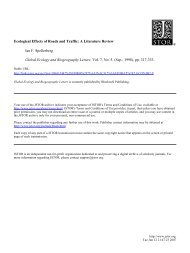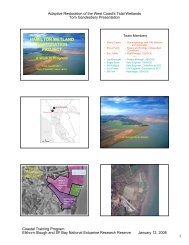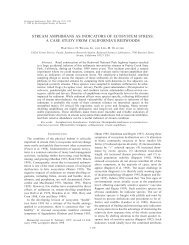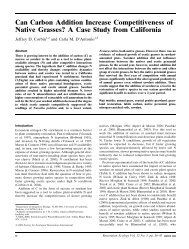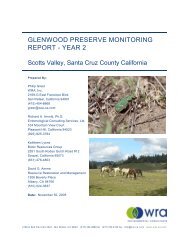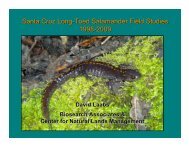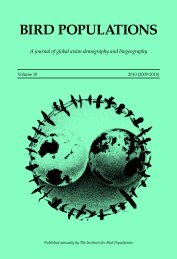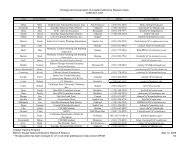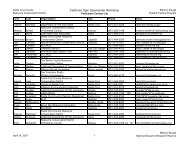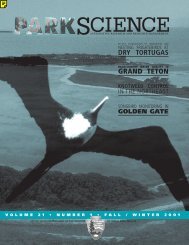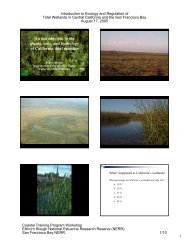116 BIOLOGICAL CONSERVATION 133 (2006) 107– 117Dobson, A.P., Rodriguez, J.P., Roberts, W.M., Wilcove, D.S., 1997.Geographic distribution of end<strong>an</strong>gered species <strong>in</strong> the UnitedStates. Science 275, 550–553.Eckste<strong>in</strong>, R.G., O’Brien, T.F., Rongstad, O.J., Boll<strong>in</strong>ger, J.G., 1979.Snowmobile effects on movements of white-tailed deer: acase-study. Environmental Conservation 6, 45–51.Fedri<strong>an</strong>i, J.M., Fuller, T.K., Sauvajot, R.M., 2001. Does availability of<strong>an</strong>thropogenic food enh<strong>an</strong>ce densities of omnivorous<strong>mammal</strong>s? An example with coyotes <strong>in</strong> Southern California.Ecography 24, 325–331.Fernández-Juricic, E., Venier, P.V., Renison, D., Blumste<strong>in</strong>, D.T.,2005. Sensitivity of wildlife to spatial patterns of recreationistbehavior: a critical assessment of m<strong>in</strong>imum approach<strong>in</strong>gdist<strong>an</strong>ces <strong><strong>an</strong>d</strong> buffer areas for grassl<strong><strong>an</strong>d</strong> birds. BiologicalConservation 125, 225–235.Festa-Bi<strong>an</strong>chet, M., Apollonio, M. (Eds.), 2003. Animal Behavior<strong><strong>an</strong>d</strong> Wildlife Conservation. Isl<strong><strong>an</strong>d</strong> Press, Wash<strong>in</strong>gton, DC.Fr<strong>an</strong>k, L.G., Woodroffe, R., 2001. Behaviour of carnivores <strong>in</strong>exploited <strong><strong>an</strong>d</strong> controlled populations. In: Gittlem<strong>an</strong>, J.L., Funk,S.M., Macdonald, D., Wayne, R.K. (Eds.), Carnivore Conservation.Cambridge University Press, Cambridge, pp. 419–442.Freddy, D.J., Bronaugh, W.M., Fowler, M.C., 1986. Responses ofmule deer to disturb<strong>an</strong>ce by persons afoot <strong><strong>an</strong>d</strong> snowmobiles.Wildlife Society Bullet<strong>in</strong> 14, 63–68.Frid, A., Dill, L., 2002. Hum<strong>an</strong>-caused disturb<strong>an</strong>ce stimuli as aform of predation risk. Conservation Ecology 6, 11–25.Gill, J.A., Sutherl<strong><strong>an</strong>d</strong>, W.J., 2000. Predict<strong>in</strong>g the consequences ofhum<strong>an</strong> disturb<strong>an</strong>ce from behavioural decisions. In: Gosl<strong>in</strong>g,L.M., Sutherl<strong><strong>an</strong>d</strong>, W.J. (Eds.), Behaviour <strong><strong>an</strong>d</strong> Conservation.Cambridge University Press, Cambridge, pp. 51–64.Gill, J.A., Norris, K., Sutherl<strong><strong>an</strong>d</strong>, W.J., 2001. Why behaviouralresponses may not reflect the population consequences ofhum<strong>an</strong> disturb<strong>an</strong>ce? Biological Conservation 97, 265–268.Gittlem<strong>an</strong>, J.L., Funk, S.M., Macdonald, D., Wayne, R.K. (Eds.), 2001.Carnivore Conservation. Cambridge University Press,Cambridge.Gosl<strong>in</strong>g, L.M., Sutherl<strong><strong>an</strong>d</strong>, W.J. (Eds.), 2000. Behaviour <strong><strong>an</strong>d</strong>Conservation. Cambridge University Press, Cambridge.Gr<strong>in</strong>der, M.I., Krausm<strong>an</strong>, P.R., 2001. Home r<strong>an</strong>ge, habitat use, <strong><strong>an</strong>d</strong>nocturnal <strong>activity</strong> of coyotes <strong>in</strong> <strong>an</strong> urb<strong>an</strong> environment. Journalof Wildlife M<strong>an</strong>agement 65, 887–898.Grund, M.D., McAn<strong>in</strong>ch, J.B., Wiggers, E.P., 2002. Seasonalmovements <strong><strong>an</strong>d</strong> habitat use of female white-tailed deerassociated with <strong>an</strong> urb<strong>an</strong> park. Journal of WildlifeM<strong>an</strong>agement 66, 123–130.Hecnar, S.J., M’Closkey, R.T., 1998. Effects of hum<strong>an</strong> disturb<strong>an</strong>ceon five-l<strong>in</strong>ed sk<strong>in</strong>k, Eumeces fasciatus, abund<strong>an</strong>ce <strong><strong>an</strong>d</strong>distribution. Biological Conservation 85, 213–222.Jones, J.M., Witham, J.H., 1990. Post-tr<strong>an</strong>slocation survival <strong><strong>an</strong>d</strong>movements of metropolit<strong>an</strong> white-tailed deer. Wildlife SocietyBullet<strong>in</strong> 18, 434–441.Kent, M., Coker, P., 1992. Vegetation Description <strong><strong>an</strong>d</strong> Analysis. CRCPress, Boca Raton, FL.Kerley, L.L., Goodrich, J.M., Miquelle, D.G., Smirnov, E.N., Quigley,H.B., Hornocker, M.G., 2002. Effects of roads <strong><strong>an</strong>d</strong> hum<strong><strong>an</strong>d</strong>isturb<strong>an</strong>ce on Amur tigers. Conservation Biology 16, 97–108.Kilpatrick, H.J., Lima, K.K., 1999. Effects of archery hunt<strong>in</strong>g onmovement <strong><strong>an</strong>d</strong> <strong>activity</strong> of female white-tailed deer <strong>in</strong> <strong>an</strong>urb<strong>an</strong> l<strong><strong>an</strong>d</strong>scape. Wildlife Society Bullet<strong>in</strong> 27, 433–440.Kilpatrick, H.J., Spohr, S.M., 2000. Spatial <strong><strong>an</strong>d</strong> temporal use of asuburb<strong>an</strong> l<strong><strong>an</strong>d</strong>scape by female white-tailed deer. WildlifeSociety Bullet<strong>in</strong> 28, 1023–1029.Kloppers, E.L., St. Clair, C.C., Hurd, T.E., 2005. Predator-resembl<strong>in</strong>gaversive condition<strong>in</strong>g for m<strong>an</strong>ag<strong>in</strong>g habituated wildlife.Ecology <strong><strong>an</strong>d</strong> Society 10, 31.Knight, R.L., Cole, D.N., 1991. Effects of recreational <strong>activity</strong> onwildlife <strong>in</strong> wild l<strong><strong>an</strong>d</strong>s. Tr<strong>an</strong>sactions of the North Americ<strong>an</strong>Wildlife <strong><strong>an</strong>d</strong> Natural Resources Conference 56, 238–247.Knight, R.L., Gutzwiller, K.J. (Eds.), 1995. Wildlife <strong><strong>an</strong>d</strong><strong>Recreation</strong>ists: Coexistence Through M<strong>an</strong>agement <strong><strong>an</strong>d</strong>Research. Isl<strong><strong>an</strong>d</strong> Press, Wash<strong>in</strong>gton, DC.Kufeld, R.C., Bowden, D.C., Schrupp, D.L., 1988. Influence ofhunt<strong>in</strong>g on movements of female mule deer. Journal of R<strong>an</strong>geM<strong>an</strong>agement 41, 70–72.Lacy, K.E., Mart<strong>in</strong>s, E.P., 2003. The effect of <strong>an</strong>thropogenic habitatusage on the social behavior of a vulnerable species: Cyclur<strong>an</strong>ubila. Animal Conservation 6, 3–9.Losos, E., Hayes, J., Phillips, A., Wilcove, D., Alkire, C., 1995.Taxpayer-subsidized resource extraction harms species.Bioscience 45, 446–455.Lubow, B.C., S<strong>in</strong>ger, F.J., Johnson, T.L., Bowden, D.C., 2002.Dynamics of <strong>in</strong>teract<strong>in</strong>g elk populations with<strong>in</strong> <strong><strong>an</strong>d</strong> adjacentto Rocky Mounta<strong>in</strong> National Park. Journal of WildlifeM<strong>an</strong>agement 66, 757–775.MacArthur, R.A., Geist, V., Johnston, R.H., 1982. Cardiac <strong><strong>an</strong>d</strong>behavioral responses of mounta<strong>in</strong> sheep to hum<strong><strong>an</strong>d</strong>isturb<strong>an</strong>ce. Journal of Wildlife M<strong>an</strong>agement 46, 351–358.MacCracken, J.G., 1982. Coyote foods <strong>in</strong> a southern Californiasuburb. Wildlife Society Bullet<strong>in</strong> 10, 280–281.Magle, S., Zhu, J., Crooks, K.R., 2005. Behavioral responses torepeated hum<strong>an</strong> <strong>in</strong>trusion by black-tailed prairie dogs(Cynomys ludovici<strong>an</strong>us). Journal of Mammalogy 86, 524–530.Ma<strong>in</strong><strong>in</strong>i, B., Neuhaus, P., Ingold, P., 1993. Behaviour of marmotsMarmota marmota under the <strong>in</strong>fluence of different hik<strong>in</strong>gactivities. Biological Conservation 64, 161–164.McClennen, B.N., Shackleton, D.M., 1989. Immediate reactions ofgrizzly bears to hum<strong>an</strong> activities. Wildlife Society Bullet<strong>in</strong> 17,269–274.McClennen, N., Wigglesworth, R.R., Anderson, S.H., Wachob, D.G.,2001. The effect of suburb<strong>an</strong> <strong><strong>an</strong>d</strong> agricultural development onthe <strong>activity</strong> patterns of coyotes (C<strong>an</strong>is latr<strong>an</strong>s). Americ<strong>an</strong>Midl<strong><strong>an</strong>d</strong> Naturalist 146, 27–36.McClure, M.F., Smith, N.S., Shaw, W.W., 1995. Diets of coyotes nearthe boundary of Saguaro National Monument <strong><strong>an</strong>d</strong> Tucson,Arizona. The Southwestern Naturalist 40, 101–125.McCullough, D.R., Jenn<strong>in</strong>gs, K.W., Gates, N.B., Elliott, B.G.,DiDonato, J.E., 1997. Overabund<strong>an</strong>t deer populations <strong>in</strong>California. Wildlife Society Bullet<strong>in</strong> 25, 478–483.Miller, S.G., Knight, R.L., Miller, C.K., 1998. Influence ofrecreational trails on breed<strong>in</strong>g birds communities. EcologicalApplications 8, 162–169.Miller, S.G., Knight, R.L., Miller, C.K., 2001. Wildlife responses topedestri<strong>an</strong>s <strong><strong>an</strong>d</strong> dogs. Wildlife Society Bullet<strong>in</strong> 29, 124–132.Myers, N., 1990. The biodiversity challenge: exp<strong><strong>an</strong>d</strong>ed hot-spots<strong>an</strong>alysis. The Environmentalist 10, 243–256.Naugle, D.E., Jenks, J.A., Kernoh<strong>an</strong>, B.J., Johnson, R.R., 1997. Effectsof hunt<strong>in</strong>g <strong><strong>an</strong>d</strong> loss of escape cover on movements <strong><strong>an</strong>d</strong><strong>activity</strong> of female white-tailed deer, Odocoileus virg<strong>in</strong>i<strong>an</strong>us.C<strong>an</strong>adi<strong>an</strong> Field-Naturalist 111, 595–600.Nev<strong>in</strong>, O.T., Gilbert, B.K., 2005a. Perceived risk, displacement <strong><strong>an</strong>d</strong>refug<strong>in</strong>g <strong>in</strong> brown bears: positive impacts of ecotourism?Biological Conservation 121, 611.Nev<strong>in</strong>, O.T., Gilbert, B.K., 2005b. Measur<strong>in</strong>g the cost of riskavoid<strong>an</strong>ce <strong>in</strong> brown bears: further evidence of positiveimpacts of ecotourism. Biological Conservation 123, 453–460.Olson, T.L., Gilbert, B.K., Squibb, R.C., 1997. The effects of<strong>in</strong>creas<strong>in</strong>g hum<strong>an</strong> <strong>activity</strong> on brown bear use of <strong>an</strong> Alask<strong>an</strong>river. Biological Conservation 82, 95–96.Papouchis, C.M., S<strong>in</strong>ger, F.J., Slo<strong>an</strong>, W.B., 2001. Responses of desertbighorn sheep to <strong>in</strong>creased hum<strong>an</strong> recreation. Journal ofWildlife M<strong>an</strong>agement 65, 573–582.Pimm, S.L., Jones, H.L., Diamond, J., 1988. On the risk ofext<strong>in</strong>ction. Americ<strong>an</strong> Naturalist 132, 757–785.Qu<strong>in</strong>n, T., 1997a. Coyote (C<strong>an</strong>is latr<strong>an</strong>s) habitat selection <strong>in</strong> urb<strong>an</strong>areas of western Wash<strong>in</strong>gton via <strong>an</strong>alysis of rout<strong>in</strong>emovement. Northwest Science 71, 289–297.
BIOLOGICAL CONSERVATION 133 (2006) 107– 117 117Qu<strong>in</strong>n, T., 1997b. Coyote (C<strong>an</strong>is latr<strong>an</strong>s) food habits <strong>in</strong> three urb<strong>an</strong>habitat types of western Wash<strong>in</strong>gton. Northwest Science 71,1–5.Ray, J.C., Redford, K.H., Steneck, R.S., Berger, J. (Eds.), 2005. LargeCarnivores <strong><strong>an</strong>d</strong> the Conservation of Biological Diversity. Isl<strong><strong>an</strong>d</strong>Press, Wash<strong>in</strong>gton, DC.Riley, S.P.D., Sauvajot, R.M., Fuller, T.K., York, E.C., Kamradt, D.A.,Bromley, C., Wayne, R.K., 2003. Effects of urb<strong>an</strong>ization <strong><strong>an</strong>d</strong>habitat fragmentation on bobcats <strong><strong>an</strong>d</strong> coyotes <strong>in</strong> southernCalifornia. Conservation Biology 17, 566–576.Rodríquez-Prieto, I., Fernández-Juricic, E., 2005. Effects of directhum<strong>an</strong> disturb<strong>an</strong>ce on the endemic Iberi<strong>an</strong> frog R<strong>an</strong>a iberica at<strong>in</strong>dividual <strong><strong>an</strong>d</strong> population levels. Biological Conservation 123,1–9.Rub<strong>in</strong>, E.S., Boyce, W.M., Stermer, C.J., Torres, S.G., 2002. Bighornsheep habitat use <strong><strong>an</strong>d</strong> selection near <strong>an</strong> urb<strong>an</strong> environment.Biological Conservation 104, 251–263.Smith, T.S., Herrero, S., DeBruyn, T.D., 2005. Alask<strong>an</strong> brown bears,hum<strong>an</strong>s, <strong><strong>an</strong>d</strong> habituation. Ursus 16, 1–10.Stalmaster, M.V., Kaiser, J.L., 1998. Effects of recreational<strong>activity</strong> on w<strong>in</strong>ter<strong>in</strong>g bald eagles. Wildlife Monographs,137.State of California, Department of F<strong>in</strong><strong>an</strong>ce, 2001. Historicalcensus populations of California state, counties, cities, places<strong><strong>an</strong>d</strong> towns, 1850–2000. Sacramento, California.State of California, Department of F<strong>in</strong><strong>an</strong>ce, 2004. Populationprojections by race/ethnicity, gender <strong><strong>an</strong>d</strong> age for California<strong><strong>an</strong>d</strong> its counties, 2000–2050. Sacramento, California.Taylor, A.R., Knight, R.L., 2003. Wildlife responses to recreation<strong><strong>an</strong>d</strong> associated visitor perceptions. Ecological Applications 13,951–963.Terborgh, J., 1974. Preservation of natural diversity: the problem ofext<strong>in</strong>ction-prone species. Bioscience 24, 715–722.Thompson, M., Henderson, R., 1998. Elk habituation as acredibility challenge for wildlife professionals. Wildlife SocietyBullet<strong>in</strong> 26, 477–483.Tigas, L.A., V<strong>an</strong> Vuren, D.H., Sauvajot, R.M., 2002. Behavioralresponses of bobcats <strong><strong>an</strong>d</strong> coyotes to habitat fragmentation<strong><strong>an</strong>d</strong> corridors <strong>in</strong> <strong>an</strong> urb<strong>an</strong> environment. BiologicalConservation 108, 299–306.Wagner, K.K., Schmidt, R.H., Conover, M.R., 1997. Compensationprograms for wildlife damage <strong>in</strong> North America. WildlifeSociety Bullet<strong>in</strong> 25, 312–319.White Jr., D., Kendall, K.C., Picton, H.D., 1999. Potential energeticeffects of mounta<strong>in</strong> climbers on forag<strong>in</strong>g grizzly bears.Wildlife Society Bullet<strong>in</strong> 27, 146–151.Whittaker, D., Knight, R.L., 1998. Underst<strong><strong>an</strong>d</strong><strong>in</strong>g wildliferesponses to hum<strong>an</strong>s. Wildlife Society Bullet<strong>in</strong> 26, 312–317.Wilcove, D.S., Rothste<strong>in</strong>, D., Dubow, J., Phillips, A., Losos, E., 1998.Qu<strong>an</strong>tify<strong>in</strong>g threats to imperiled species <strong>in</strong> the United States.Bioscience 48, 607–615.Woodroffe, R., 2000. Predators <strong><strong>an</strong>d</strong> people: us<strong>in</strong>g hum<strong>an</strong> densitiesto <strong>in</strong>terpret decl<strong>in</strong>es of <strong>large</strong> carnivores. Animal Conservation3, 165–173.Woodroffe, R., G<strong>in</strong>sberg, J.R., 1998. Edge effects <strong><strong>an</strong>d</strong> the ext<strong>in</strong>ctionof populations <strong>in</strong>side protected areas. Science 280, 2126–2128.Yalden, P.E., Yalden, D.W., 1990. <strong>Recreation</strong>al disturb<strong>an</strong>ce ofbreed<strong>in</strong>g golden plovers, Pluvialis apricarius. BiologicalConservation 51, 243–262.Yarmoloy, C., Bayer, M., Geist, V., 1988. Behavior responses <strong><strong>an</strong>d</strong>reproduction of mule deer, Odocoileus hemionus, does follow<strong>in</strong>gexperimental harassment with <strong>an</strong> all-terra<strong>in</strong> vehicle.C<strong>an</strong>adi<strong>an</strong> Field-Naturalist 102, 425–429.Zakai, D., Chadwick-Furm<strong>an</strong>, N.E., 2002. Impacts of <strong>in</strong>tensiverecreational div<strong>in</strong>g on reef corals at Eilat, northern Red Sea.Biological Conservation 105, 179–187.



